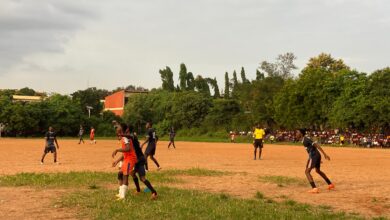ULYMPICS: Fiercest Faces and Contending Classes

Amidst the hustles and bustles of the ever-strenuous medical school, is a deep longing and yearning for a breather, one so refreshing that could afford the opportunity to effectively recalibrate for the challenges ahead. With each passing year, the Ulympics has answered the call. This annual ritual seeks to unite the length and breadth of UIMSAites through the spirit of sports.
This year’s sporting event which kick-started on the 16th of November, is absolutely no different as we have already seen how strong of a unifying factor sport is. In this article, we shall be taking a closer look at the chances each class has of clinching the gold medal in each sporting area, taking into consideration some of the ties already underway.
Volleyball
This sport happened to be the opener of this year’s sporting event. As usual, it was highly anticipated and as it is with every sporting event in UIMSA, there was an eager expectation as to what the tournament debutants, the 100-level class, in this case, 2k27 had to offer. The first match was a faceup between the tournament favourites (2k24) and the newbies (2k27). As expected, given the wealth of experience the 2k24 class had garnered, along with the possession of key players like Oludehinwa Adura and Alabi Funke in their arsenal, the game turned out to be a white-washing as the 2k27 class were sent to the cleaners.
The second game of the evening was mind-blowing as the 2k26 class, popularly known as Imperium went head-to-head with the 2k23 class, Invictus. Surprisingly, with a great deal of composure, team spirit and a spice of individual brilliance here and there, the 2k26 class beat the 2k23 class in their backyard. Though it didn’t come easy as a tie-breaker settled the exchanges, the effort put together by the 2k26 class must be lauded and very much appreciated. Speaking to one of the players in the 2k23 class, he stated that about 90% of the squad members just started playing the sport (volleyball) just a week ago but he still didn’t take anything away from the stellar performance that the 200-level class put in. He is optimistic that his team is on the right track, primed for greatness.
The showdown of the day was between the 2k25 class, also known as Mavericks, and the 2k21 class, Insignis. This matchup happened to be a repeat of the semi-finals of last year’s tournament but unlike last year’s, the margin of the score was quite larger as the 2k21 class, for the second time running, snatched the victory. As usual, stars such as Obiekwe Franklin, Uche, and the ever-versatile Eseosa shone brightly during the encounter. Ebenezer Bolaji, Sanni Oluwatobilola, and Abang Possible of the 2k25 class all put in a very impressive performance but sadly, their best wasn’t enough.
With the preliminary round done and dusted, the semi-final stage is set as 2k26 will be battling against 2k24, while 2k23, who qualified as the best losers, will be taking on 2k21. Statistically and going by antecedents, on paper, a final between 2k24 and 2k21 seems certain but with sports, you can never write off any team. The 2k26 team is currently on a fairy tale run, fueled by the master class of players like John-Paul Ugwuegbu and Oluwagbemisola Olubanjo. Will they be the orchestrators of an upset? Only time will tell. The 2k23 side is also no pushover as they are very intentional about improving before the semi-finals in January.
Football
All sports are relatively welcomed and provide a different level of spice and finesse but unarguably, football hits differently. Time and again, football has proven to be the climax of every Ulympics tournament, spreading excitement and anxiety across the hearts of fans and enthusiasts. This time out will be no different. As it has been in recent years, it is subdivided into the male and the female categories.
For the male category, there are two groups, A and B respectively. From the draws made, Group A consists of: 2k24, 2k21 and 2k26 while Group B consists of: 2k25, 2k27 and 2k23. By popular opinion, Group B has been labelled the group of death because of the footballing prowess shown by 2k25 and 2k23 and the great footballing promise shown by 2k27. According to the rules, two teams will break out of the group stage and proceed to the semifinals. For the 2k27 class, they have already shown that they are no pushovers. During the annual freshers’ welcome, they held their immediate seniors 2k26 to a one-all draw but in the pre-NIMSA heat, however, they walloped the 2k26 class by 3-1. In a friendly held between themselves and the 2k24 class, it wasn’t one-way traffic as they showed some promise despite losing 3-1. Players such as Adegoke ‘Prestige’ Oluwasegun, Sunday Peter, and Okolo Kingsley, are to be watched out for as these trio have proven to be made up of great substance.
The 2k25 class, despite beginning their Ulympics journey on a terrible note, have improved greatly, so much so that one could dare say that they are the most improved team in the entire UIMSA. During the last Ulympics, they emerged as group winners in a group that had the 2k19 Panthers, coached by Mark Obeya. Although they were humiliated in the semi-finals by the 2k21 class, it was a better outing than in the previous year. With players such as Toyeeb Salawu, Edet Francis, Eben, Adeleye Tise, Daniel Bright, Oladunni Samad, Possible Abang and a host of other stars, the team led by Ojile Moses looks primed for an excellent outing.
The 2k23 class is another class that cannot be pushed aside as they are gifted with excellent players such as Habeeb, Ola, and Istanbul, to name a few. The last Ulympics was one to forget as they were knocked out as early as the group phase. Although an excuse of being drawn in the group of death at the time could be made for them, it was still a poor performance. They have a point to prove this time out as they hope to put the setback of the last Ulympics behind them. According to the bookmakers, 2k25 and 2k23 are expected to qualify, with 2k25 likely topping the group.
Going back to group A, the 2k24 class has represented excellence in football with their intentional and mesmerizing midfield play. Such midfield prowess has been made possible by the presence of maestros like Olokungbemi Gerald, Akinnusoye David, and Adeji-Paul Promise. They are also not shy up top as they have the never relenting Jide as the pointman. In every Ulympics, they have always made their presence felt, emerging as table toppers of the group of death in the last outing, which goes to show how formidable they are.
The 2k21 class needs no introduction as they are the current champions of the Ulympics football tournament after they beat Panthers in a dramatic final last year. With the presence of players like Karbon, Teslim, and Ayotunde, they look set to go all out to retain their title.
The 2k26 class on the flip side have been very far from impressive. They have been on the receiving end of unpalatable results in recent times with the most prominent being the 3-1 loss to the 2k27 class. In the last Ulympics, they finished bottom of the group with no single point gained and 1 goal scored. This year, it is safe to say that they are unlucky to be paired in a group with 2k24 and 2k21.
Between the 2k24 and 2k21 classes, history favours the 2k24 class to top the group as the 2k21 class are known to be traditionally late bloomers as they tend to hit the peak of their powers in the knockout stages of the competition.
The female category, sharing the same pairing as the male, is predicted to see the 2k25, 2k23 and 2k21 classes make it to the semifinals with stars such as Chidinma Onyiuke of the 2k23 class, Ofumwengbe-Eseosa and Victoria Kolawole of the 2k21 class and Shola Balogun of the 2k25 class expected to turn up for their respective teams. It is believed that the 2k24, 2k27 and 2k26 classes will all battle it out for who will complete the semi-final quart.
Basketball
This is a sport in UIMSA with not-so-many athletes to look out for. Regardless, we still have quite a number to admire in different classes. In the 2k27 class, Michael Ilenikhena and Adeola Adekojo are worthy enough to have an eye on. The freshmen would definitely have this duo represent them in male and female basketball, respectively. The 2k26 class has Rodiyah Khidir, a female basketball enthusiast who’s expected to bear the flag of her class in this Ulympics. 2k25 has Mustapha Salaudeen to lead fellow players on the court to score as many 1s, 2s, and 3s as possible.
The 2k24 class has some set of players who show some not-so-consistent interest in the sport, but are sure to represent for the medal’s sake like Moboluwarin Ogunleye, Ademola Ayomide, and Ijezie Collins. The 2k23 has UI Small-Forward, Onyinyechi Osisiogu, Agboke Emmanuel, and other team players. 2k21, the finalists, have Precious Idiaye, Mujeeb, Ismail, and Goodness. From this analysis, the 2k21 class just might walk away with male basketball gold, except some magic happens. It’s not so clear for the female basketball now, but time will be a good judge.
Athletics
Athletics has proven to be one of the fast-growing sports in the Ulympics games. Last year, we witnessed stars on show from different classes show what they are made of in both the track and field events. The 2k25 class had a very clean sweep of the medals in the male category as athletes such as Eben, Soriwei Emmanuel, and Okoli Ebube all came out shining. Emmanuel Soriwei who won four medals for UIMSA at the NIMSA games is set to be the centre of attraction once again as he will seek to perform better. The 2k27 class seem to have interesting upcoming athletes who were on show during the pre-NIMSA heat. It remains to be seen how many more talents will be unraveled at this year’s event.
Indoor Games
The indoor games are more like an open cheque except for the male chess category where Blessing Bayo of the 2k25 class and Simeon Okojie of the 2k24 class have shown a great deal of dominance and female table tennis where Eseosa of the 2k21 class and Shola of the 2k25 class have consistently shown their mettle. Olabisi Olaoluwa from the 2k23 class is a worthy name for the male table tennis, alongside NiMSA, Inter-Faculty, Inter-Hall, and Ulympics multi-medallist, Opara Charles of the 2k21 Class. The other games like Scrabble, ludo, checkers and a host of other indoor games remain to be seen as to who will emerge victorious.
This year’s Ulympics promises to be super exciting and we all can’t wait to witness what this tournament holds for the fans.
Okoronkwo Nmesomachi.





My name is Oluwagbemisola Olubanjo not Gbemisola Banjo 🥲